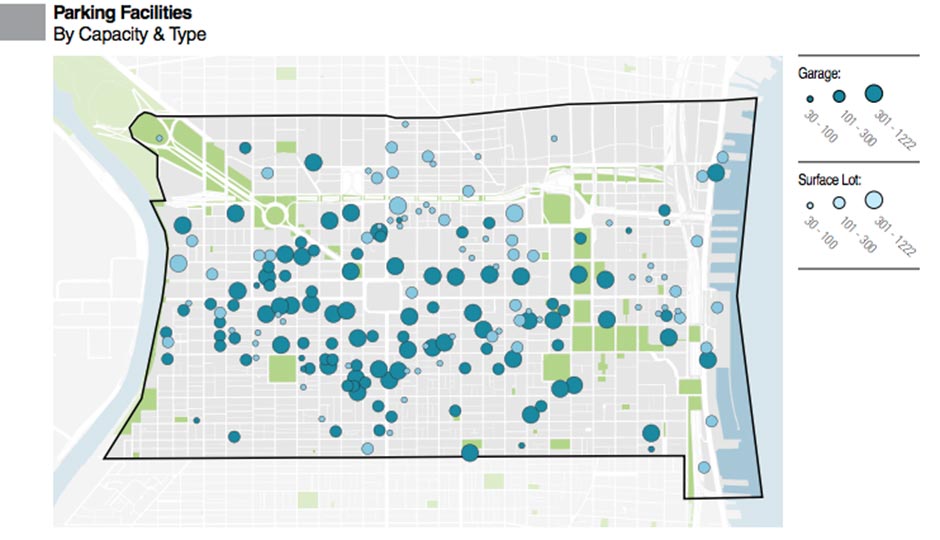Study: Center City Lost 7 Percent of Off-Street Public Parking

Center City parking facilities by capacity and type, via the Philadelphia City Planning Commission’s 2015 Center City Parking Inventory study.
The Center City construction boom has converted a bunch of parking lots into apartments and offices, resulting in a 7 percent drop in the total inventory of public off-street parking spaces in Center City from 2010 to 2015, according to the Philadelphia City Planning Commission’s 2015 Center City Parking Inventory (PDF).
New developments on 16 former surface parking lots or garages since 2010 removed 2,426 spaces from the supply of parking spaces available to the public, while only 763 spaces were added in two new projects, thus producing a net loss of 1,663 spaces. Five projects currently under construction will offer some public parking as well.
But as the number of spaces has dropped, so too has the number of cars parking in them. The 73.9 percent occupancy rate for public parking spaces represents a decline of 1.7 percentage points since 2010 and 3.8 percentage points since the peak survey year of 2005.
One reason for the fall-off in utilization: It keeps getting more expensive to park short-term off-street while on-street metered spaces remain bargains.
The average cost to park for one hour in a Center City garage in 2015 is $13.39, up 23 percent from 2010. Some of that increase comes from a hike in the city’s parking tax last year from 20 percent to 22.5 percent, the first increase since 2008. That makes Philadelphia the fourth-most-expensive city for short-term off-street parking in the United States, according to Colliers International survey data cited in the city study. Yet while the average daily parking rate of $25.50 is also quite expensive — 10th highest in the country, according to that same survey — most Center City garages offer commuters who drive to work steeply discounted “early bird” rates that make parking for eight to 10 hours starting in the morning about as expensive as parking for one hour.
Meanwhile, the study points out, on-street parking spaces are actually underpriced, which is why finding an open one is such a frustrating task. Because on-street spaces are almost always full in the densest parts of the city during the day, drivers coming to Center City for short visits often turn to garages as a last resort, and garage operators feel no need to take on-street parking rates into account when setting their own.
Yet the net reduction in parking utilization also suggests that fewer people may be driving into Center City. As a Plan Philly article on the inventory report notes, the share of Philadelphians making trips by bike, by transit or on foot climbed steadily from 2009 to 2012 before declining slightly in 2013, while vehicle miles traveled trended downward during that same period save for a brief uptick in 2012.
The Planning Commission recommends that the city adopt dynamic pricing of on-street parking spaces in order to free up on-street parking and encourage drivers to use garages when visiting Center City for more than an hour or two. New technology makes this possible, and some other large cities, most notably San Francisco and Los Angeles, have now implemented dynamic pricing policies as a result. The report notes that the Philadelphia Parking Authority’s meterUP app already lets on-street parkers extend their time beyond the posted limit at a higher rate for a short period of time. Plan Philly notes that the administration of former Mayor Michael Nutter has had this as a policy goal since 2009, but the Parking Authority has yet to endorse the idea.
2015 Parking Study by PhiladelphiaMagazine


